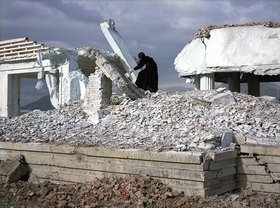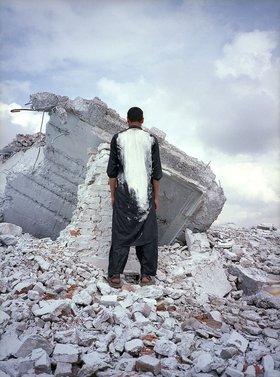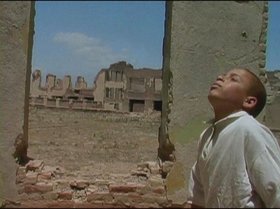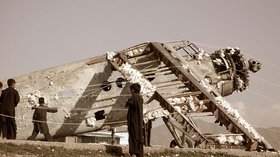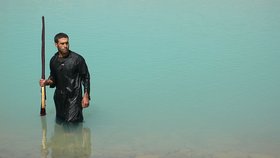Interviews
What We Choose To Overlook
Lida Abdul in conversation with Sara Raza
Lida Abdul is an Afghan video and performance artist born in 1973 in Kabul. Forced to flee Afghanistan following the Russian invasion and the war that followed, Abdul lived as a refugee in Germany and India before settling in the US, where she has been based now for over two decades, dividing her time between LA and Kabul. Her works poetically document disasters that have befallen her native country - the Russian invasion, the infiltration of the Taliban regime and the American 'War on Terror' - all of which have inspired Abdul to create highly emotional works that reflect on the subject of life post-devastation. In this interview with Sara Raza, Abdul discusses her works dealing with trauma and healing post-devastation.
Sara Raza: Having experienced forced migration from your native Afghanistan, you returned to Kabul in 2001 to document the changes that had affected your country, particularly the devastation of its monuments and ruins. What drew you to document spaces of post-devastation?
Lida Abdul: My practice has always been underlined by a study of informal architecture and how architecture bears witness to the scars that are inflicted on the urban space. When I first returned to Kabul after an almost 20-year absence I witnessed two things in abundance: ruins and graves. There was also an increasing number of public monuments, which I found rather unsettling.
SR: The culture of monumentality is synonymous with Central Asia, especially since the collapse of the Soviet Union and the end of the Soviet-Afghan war, wouldn't you say?
LA: Yes that's true, but really monuments are cover-ups for ruins for me, they mask the trauma, death and suffering that people have endured during conflict and the struggle for independence. It's interesting that instead of acknowledging failure we erect concrete walls in order to detract from the horror of violence and conflict.
SR: So would you say your works are anti-monumentality?
LA: Perhaps you could say that, as much of my video works deal with the former USSR's invasion in Afghanistan and tries to engage with the distance between the actual events. In many ways, my works reflect an anti-monument ethos in that they are composed from the remnants of everyday life; I use symbols such as rocks, rope, and ruins to create a poetic analysis of the current situation in Afghanistan.
SR: In your epic work White House (2005), which you debuted at the inaugural Afghan Pavilion at the 51st Venice Biennale, you presented a video in which you are shown painting the ruins of Kabul white and eventually turn your attention to a lone Afghan man, and extend the metaphor of anti-monumentality by eventually painting the man's back white.
LA: I was definitely attempting to create a visual metaphor for healing and trauma that still lingers within spaces of post-devastation within White House. Afghanistan is a country that is still recovering from its wounds. The destruction extends from the physical architecture of the city to that of the Afghan male body too.
SR: In later works your protagonists are largely children, such as in Dome (2005). Why did you choose to work with this particular protagonist?
LA: Children who live through conflict are surrounded by realities that they cannot fully comprehend and are therefore oblivious to atrocities. In Dome there is a really beautiful encounter with chance. I was travelling with my camera crew to the outskirts of Kabul and came across this ruined mosque. There I saw a child dancing and whirling like a dervish and above him was an American war plane. He was totally unaware of his surroundings and was consumed in playing.
SR: It has often amazed me how resilient children can be and in terms of cultural memory. What they absorb via osmosis is really interesting and this is really evident for me in your later work In Transit (2008), in which children toy with the memory of conflict through play.
LA: In Transit features a group of children who are playing at the site of an abandoned Soviet war plane. They are trying to repair it and fill the bullet holes with cotton wool, and even tie strings to it and attempt to resurrect it and fly it like a kite. Here I wanted to film children because in some sense they represent a kind of fantasy world - they are willing to forget a little in order to move forward, something their parents' generation is less capable of. The children approach the theme of violence by disarming it through and playfulness.
SR: The film is beautifully shot and reminds me of Armenian-Georgian filmmaker Sergei Parajanov's iconic filmic vistas. Is he an influence in your work?
LA: The work was actually inspired by Parajanov's masterpiece The Colour of Pomegranates (1968) as well as the beauty of Iranian post-revolutionary cinema, where children are often employed as metaphors and similes for much wider social issues that reflect the fragmentation of society.
SR: Although you have exhibited internationally, what has been the reception of your work in Afghanistan?
LA: My earlier works in Aghanistan were received with curiosity and pleasure. One has to understand that there is a very limited art audience there; it's still a new phenomena. I think after the disaster that Afghanistan endured, people need to look at things that are completely unfamiliar to them. The society is still healing and there's still a lot of work to do in terms of rebuilding an infrastructure for civil society and contemporary art. Nothing can truly change until the wider social culture changes.
SR: In your recent work commissioned for dOCUMENTA13, you created a two-screen video installation shot on 16mm film called What We Have Overlooked (2011) that explored in poetic visual form a narrative involving a man attempting to plant a flag in the sea, but failing and eventually dying. Is this work a visual metaphor for the current situation in Afghanistan?
LA: In some cases, yes it is, but it is also a metaphor for a situation that is unbalanced and where there is no solid footing - like the protagonist in the film who is searching for a foundation in which to plant his flag, but ultimately fails. There is also a wider message here that is exploring the idea of nationalism and pride and the precarious relationship one has with nationhood. The flag is an abstract symbol but for many a marker of patriotic identity and for others a symbol of skepticism.
Lida Abdul was born in Afghanistan in 1973 and fled the country soon after the Soviet invasion. Since becoming a visual artist, she has exhibited widely and internationally, with solo projects at the 51st Venice Biennial, Kunsthalle Vienna, Museum of Modern Art, Arnhem, Netherlands, Miami Cantral, CAC Centre d'art Contemporain de Brétigny, Frac Lorraine Metz, Tate Modern, and the Museum of Modern Art, New York, among others. She has also exhibited in festivals and biennials in Mexico, Spain, Germany, Uzbekistan, Kyrgyzstan, Brazil, Korea and Afghanistan.

